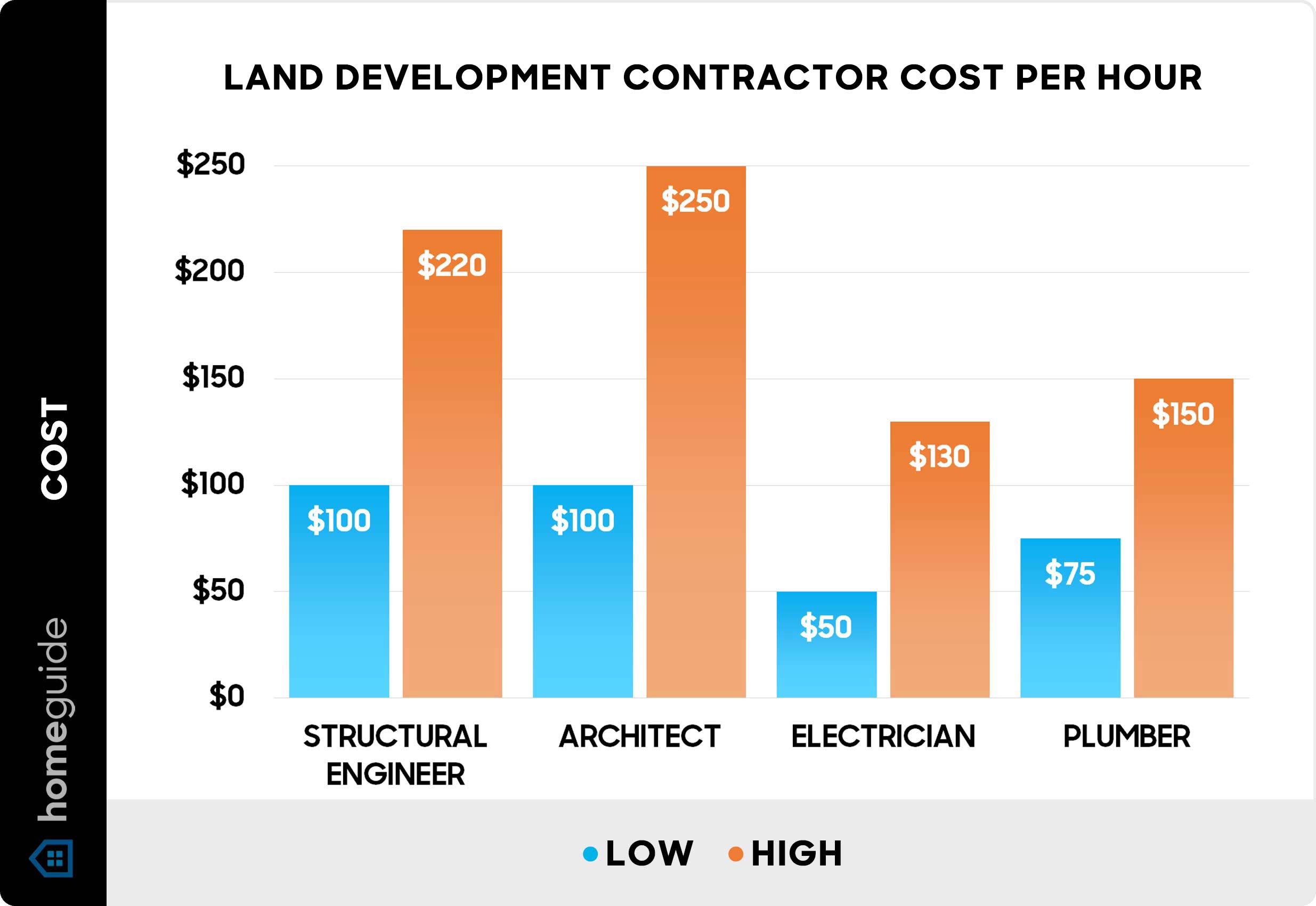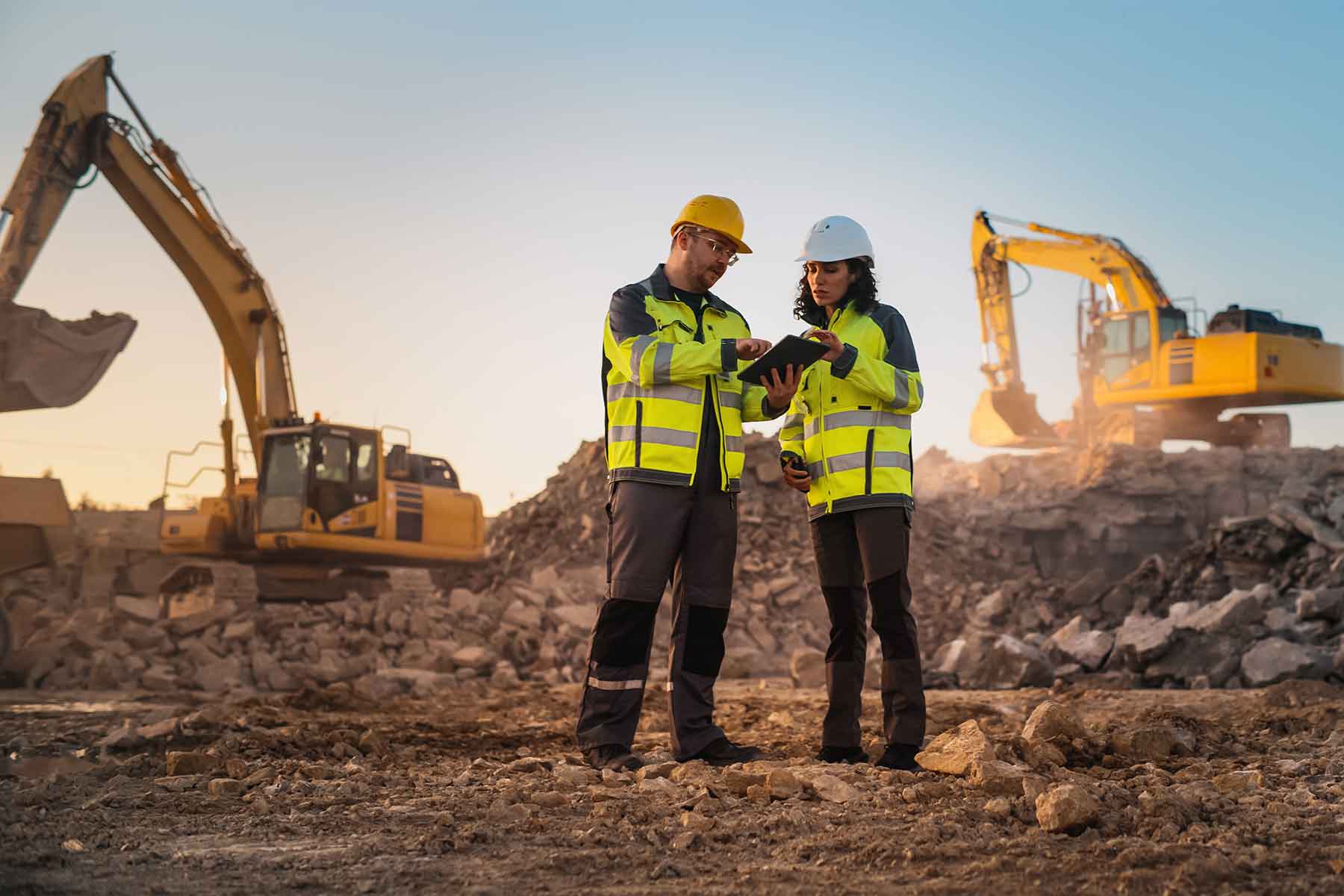
How much does it cost to develop land?
How much does it cost to develop land?
$20,000 – $100,000 total cost per acre
$10,000 – $50,000 total cost (1/2 acre)
Average cost to develop land
Land development costs $20,000 to $100,000 per acre on average, depending on the size and condition of the existing lot and how much clearing or grading it needs. A half-acre lot costs $10,000 to $50,000 to clear and prepare for building, not including the cost of the land itself.
| Plot size* | Average cost |
|---|---|
| 5,000 square feet | $2,300 – $11,500 |
| 10,000 square feet | $4,600 – $23,000 |
| 1/2 acre | $10,000 – $50,000 |
| 1 acre | $20,000 – $100,000 |
| 2 acres | $40,000 – $200,000 |
| 5 acres | $100,000 – $500,000 |
*One acre of land is equal to 43,560 square feet.
Land development cost calculator
Depending on the condition of your land, you may or may not have to remove trees and brush, dig up rocks, and level hilly or uneven areas. Then you'll need to run electricity, water, and gas lines to the property before building.
| Factor | Average total cost | Average cost per acre |
|---|---|---|
| Land clearing cost | $1,200 – $3,700 | $1,500 – $6,700 |
| Excavation cost | $1,100 – $10,000+ | $1,000 – $3,000+ |
| Land survey cost | $200 – $1,200 | $500 – $1,000 |
| Leveling and regrading cost | $1,000 – $5,000+ | $17,400 – $43,600 |
| Utility connection cost | $9,000 – $34,500 | N/A |
These other factors also influence the total cost:
Lot acquisition: Before you do any work, you have to own the land itself. Land costs $1,000 to $18,000+ per acre depending on the location.
Location: Rural or modest land development projects cost less than building on land in suburban or metropolitan areas.
Project size: Larger projects may reduce per-unit costs, while small projects may face higher per-unit expenses.
Impact tests: Municipalities often charge fees to offset the impact of new development on local infrastructure, especially near sensitive environmental areas. A geotechnical report costs $1,000 to $5,000 and confirms the safety of the ground before building. Impact fees, especially near water or in regulated areas, can add $1,000 to $25,000 or more.
Permits: Permitting costs vary by municipality and can range from $200 to $1,000 for basic services, or up to $500,000+ for large developments.
Construction: Once your land is prepped, you're ready to build your home or structure, which vary widely in cost:
Building a home costs $180 to $400+ per square foot.
Building a log cabin costs $100 to $300 per square foot.
A tiny house costs $150 to $250+ per square foot.
Commercial construction costs $240 to $870 per square foot.
Labor
In order to plan your project and prepare the land for building, you may have to hire a variety of construction-related professionals:

| Contractor type | Average hourly rate |
|---|---|
| Structural engineer cost | $100 – $220 |
| Architect cost | $100 – $250 |
| Electrician cost | $50 – $130 |
| Plumber cost | $75 – $150 |
Utility connection
The cost to get utilities on vacant land is $9,000 to $34,500+, depending on how far away you are from municipal systems. The farther you are, the more you'll end up paying.
| Project | Cost per linear foot | Average total cost |
|---|---|---|
| Running electricity | $5 – $25 | $2,500 – $12,500 |
| Connecting to city water | $25 – $200 | $1,000 – $6,000 |
| Connecting to city sewer | $50 – $200 | $1,600 – $10,900 |
| Installing natural gas lines | $12 – $25 | $500 – $2,000 |
If you're in a rural area, you may need one or more of the following alternative utility options:
An off-grid solar system costs $40,000 to $80,000.
A septic system costs $3,500 to $15,000.
Drilling a well costs $6,000 to $16,000 at a depth of 200 feet. Drilling costs increase for areas with rock ledge below the surface.
A propane tank installation costs $300 to $3,000.
Cost to develop land by state
Most land development projects in highly populated states fall between $22,000 to $55,000, with locations like California and New York costing more. The ranges below reflect minimum and maximum development costs in a few popular U.S. states.
The lower end reflects smaller, less complex, or rural projects. The upper end reflects larger, urban, or more complex sites. These ranges include clearing, grading, basic permitting, and utility connections, but not the purchase price of the land itself.
| State | Average total cost |
|---|---|
| California | $35,000 – $75,000 |
| Florida | $25,000 – $55,000 |
| Georgia | $22,000 – $45,000 |
| Illinois | $23,000 – $48,000 |
| Michigan | $22,000 – $45,000 |
| New York | $30,000 – $65,000 |
| North Carolina | $24,000 – $50,000 |
| Ohio | $23,000 – $47,000 |
| Pennsylvania | $24,000 – $48,000 |
| Texas | $22,000 – $50,000 |
Tips for saving money on land development
To help keep your overall costs low without compromising on quality, follow these tips:
Conduct thorough research: Investigate zoning, environmental constraints, and market trends before purchasing land.
Work with professionals: Engage experienced architects, engineers, and project managers to avoid costly mistakes.
Consider phased development: For large projects, develop in phases to manage cash flow and reduce risk.
Leverage incentives: Explore tax credits or grants for green infrastructure or affordable housing.
What is land development?
Land development is the process of transforming raw or undeveloped land into usable property for residential, commercial, or industrial purposes. This process involves site preparation, installing infrastructure such as roads and utilities, securing permits, and ensuring compliance with zoning and environmental regulations.
The goal of land development is to make the land suitable and ready for construction or other intended uses.
What do land developers do?
Land developers oversee and coordinate all aspects of preparing land for new uses. They acquire property, conduct due diligence, manage site clearing and grading, ensure utility connections, and navigate permitting and regulatory requirements.
Developers also work with engineers, architects, and contractors to design and implement infrastructure, ultimately making the land ready for building or sale.
How long does it take to develop land?
The time required to develop land varies widely based on project size, location, and complexity. Small residential projects may take several months, while larger commercial or multi-phase developments can require 1 to 3 years or more.

Getting estimates from contractors
When searching for building contractors and land clearing services near you, remember to:
Look for professionals who specialize in land development.
Ask for detailed estimates that break down all material and labor expenses, permit charges, and any other related costs.
Request itemized quotes from multiple contractors to ensure you're making accurate, side-by-side comparisons.
Be wary of bids that seem unusually low. Take into account the contractor's experience, references, and how thorough their estimate is.
Avoid paying the full amount up front; wait until they finish the project and it successfully passes all required inspections.
Questions to ask a contractor
Before hiring anyone for your land development project, ask these essential questions:
How many years of experience do you have in land development, and can you provide examples of similar projects?
What is your process for assessing a site's feasibility and potential challenges?
Can you walk me through the typical timeline for a project like mine?
How do you handle permitting and compliance with local zoning and environmental regulations?
What professionals do you include in your development team?
How do you estimate and manage project costs and budgets?
Can you provide references from past clients or completed developments?
What strategies do you use to address unexpected issues or delays during development?
How do you communicate progress and updates throughout the project?
Are you familiar with the specific region or municipality where my land is located?